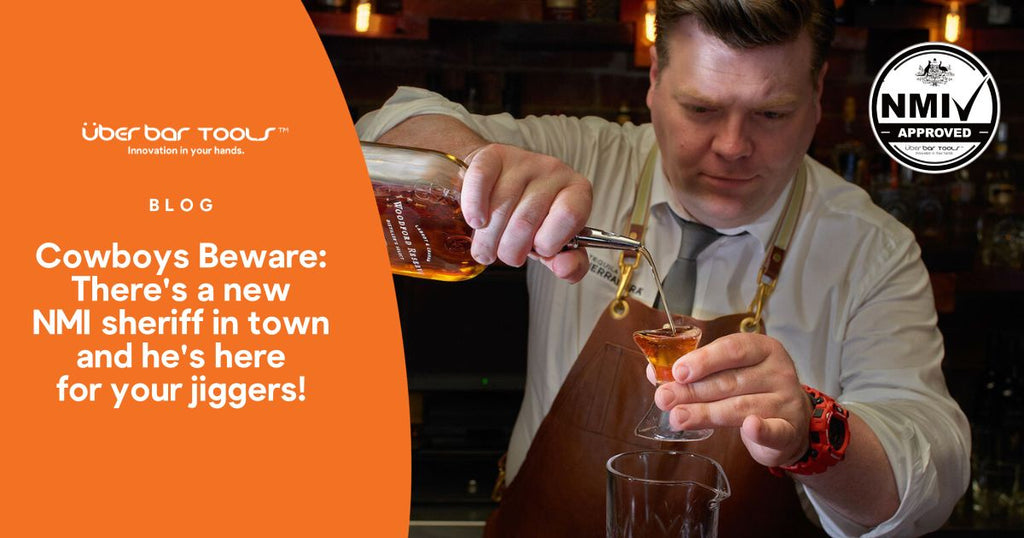News
Looking to elevate your cocktail game, streamline your bar operations, or simply unlock the secrets of the perfect pour? You've come to the right place!
At Überbartools™, we're passionate about all things bar-related, and we're dedicated to sharing our knowledge and insights with you.

Cowboys Beware: There's a new NMI sheriff in town and he's here for your jiggers!
Watch out! Are you one of the hospitality operators willfully under-serving spirits and beer or not using correct jiggers to take advantage of patrons?

How long should your customer wait for a drink? PART TWO

The one question you should ask for 2019? How long should your customer wait for a drink?
Like many people getting back down to business this January, you're probably looking at the how, what, why, when of the year.
But there's one simple question, that may help you answer a lot of those other questions....
How long should a guest wait for their drink?
TOO LITTLE TOO MUCH!
Add Value...Avoid Discounting
A competitive marketplace gives rise to the feeling one needs to discount to generate, to maintain or increase sales. But when you’re a destination retail or hospitality business, then there's smarter ways to go before going down discount alley.

WTcF... WHERE'S THE CUSTOMER FOCUS
VR - WALKING IN YOUR CUSTOMER'S SHOES
The Agreeable vs The Angry Cheftator
All Consuming Consumables

Deconstructed Menus

ENTER-DINING: HOW COCKTAILS AND LIFESTYLE MERGE

In the search for emotional as well as inter connected experiences, Millennials are increasingly making choices based on how they “feel” or make others feel.
Very much rooted in the less is more genre; consumers are now actively seeking options where quality, authenticity and provenance seamlessly live.
Helped by the myriad of cooking and lifestyle shows filling the air waves, educated consumers are changing their year round eating and drinking habits. This experience we call enter-dining
Some of the arising consequences of this food and drink fest: food choices becoming healthier with accompanying beverage choices becoming more premium!
ProConsumers (the name given to the educated, experienced, serious minded home consumer), are investing in more expensive craft beers, wines and spirits to improve dining experiences by better delineating between flavours, taste and context.
Degustation menus are being homed, with more consumers understanding that cocktails can be enjoyed as an individual solitary occasion as well as a perfect accompaniment to a series of courses, surpassing other more typical prepared bottled alternatives such as wine.
 Stirred drinks such as Manhattan’s, Negroni’s and Martini’s together with a whole bunch of rediscovered classics are being taken from the bar and replicated at home.
Stirred drinks such as Manhattan’s, Negroni’s and Martini’s together with a whole bunch of rediscovered classics are being taken from the bar and replicated at home.
The rise of bar cocktail culture with the knowledgeable bartender at its lead can be credited with the renaissance now seen where cocktails, lifestyle and entertaining experiences merge to provide for more memorable and enjoyable occasions!
WHAT'S IN YOUR DRINK?

Most of us are guilty of flipping a bottle, can or packet to check the content label for the sugar, fat and preservatives contained therein.
Many of us understand: we are what we eat; therefore cant the same be said about the things we drink too: such as spirits, wine and sparkling (SWS)?
Soft drinks and most beers routinely display nutritional information on content labels, strangely though (SWS) do not!
In a quickly changing world what would happen when consumers demand the same level of nutritional compliance on SWS.
Spirits in particular are renowned for using generic marketing descriptors to evoke some form of emotional connection via history and processes to differentiate against competing offers.
In the US there’ve been famous court cases started by consumer activists over “misleading claims” made by Distillers concerning what the terms “handmade” and/or “ hand crafted” really mean?
Is it only a matter of time before consumers ask far more vexing questions moving beyond “authenticity”, to demand total transparency on the contents of the liquids they drink?
We suspect this prospect may be lurking around the corner, if so, there’ll be tremendous changes on the way SWS are packaged, advertised and marketed.
Further down the track what would happen when bars, clubs and pubs are required to list on cocktail menus, calories, sugar, fat, preservatives on every drink served?
Are you prepared?

